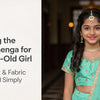How Rajasthani Bandhej Sarees Differ from Gujarati Bandhani Sarees

Bandhej has Indian origins and is practiced in both Gujarat and Rajasthan. Bandhej hails from an area renowned for its textile industry, offering a kaleidoscope of colour palettes that mark the diversity of this skill.
It offers striking differences in colours as well as culturally woven stories through each dot, which deepen with age. Through this article we will help you differentiate between the two variant sarees and appreciate them better while shopping online and offline.
A Tale Of Two Palettes: Gujarat Bandhani vs Rajasthan Bandhani colours
All regional styles have specific colours associated with their dominant style and thus arises the difference between Rajashtani and Gujarati Bandhej sarees. Rajasthan’s Bandhej displays a richness in colour spectrum dominated by royal shades such as deep maroon and dark purple accented with gold trim.
Contrarily known for energetic blends, bright hues like orange, green and pink are playfully combined, helping create vibrant patterns on garments. These are worn especially during festive seasons like Navratri & Makar Sankranti making the dress popular among Gujaratis all over.
So if out of these two zest appeals to you more, then brace yourself to be treated with either regal charm or festive brights; bandhej never disappoints.
Design Stories: Gemas- Motifs that Talk from Rajasthan and Gujarat
The design language of Bandhej is more distinctive in each region of India. In Rajasthan, the patterns frequently feature leheriya (wave lines) as well as larger chaubundi and laddu jalebi dot styles.
These motifs are arranged in such a way that they resemble palace windows and Mughal gardens. They produce an impression of graciousness blended with regal beauty. Now, that’s ideal for festive and formal attire.
In contrast to Gujarat's Bandhani, which employs smaller and tighter dots organized into grids, it also has gajji circles and kalyaana toes that are floral or festive. The work is more detailed geometric so the saree looks to have more fullness.
Each bandhej saree reveals a tale with richness of culture in every detail.
Fabrics & Texture
Rajasthani Bandhej chunri sarees come in elegant and practical styles. One can find them in pure cotton, soft malmal, flowy georgette, light chiffon and luxurious silk. Malmal and cotton provide comfort for everyday use while georgette and chiffon add a graceful drape.
Smooth silk bandhej, especially with deep colours and gota or zari detailing, are worn during weddings, religious gatherings or festive occasions. The rich finish of these fabrics and their smooth texture make the sarees visually stunning alongside the Bandhej dots.
The Deep Cultural Roots
Gujarati Bandhani sarees also include cotton and georgette which provide comfort as well as vibrant colours for daily or festive garments.
However, Bandhani in Gujarat does not only stop at sarees; it is also found in home décor items such as bed covers and cushion cases as well as men’s traditional clothing like turbans and kediyu jackets.
This reflects how deeply Bandhani has been integrated into Gujarat's cultural identity along with textile custom craftsmanship.
A Word About the Technique
The Bandhej technique begins with tying the fabric, and in Rajasthan craftsmen tie using mustard-seed-sized knots resulting in medium sized dots. These dotted patterns are associated with chaubundi which is four dots together and tikunthi three dot clusters. The end result is bold spaced out designs that showcase the fabric’s base colour exquisitely.
More skill goes into the Gujarati method as they use smaller lentil sized knots to create fine dense dot patterns resulting in more skilled work and more time spent. Also, Gujarati bandhani often undergoes multiple dyeing processes deepening layered colours and giving a stronger contrast through added depth.
Although both techniques apply astonishing design to fabrics, regions differ for detailing, colour depth, finishing touches, etc. This brings precision to each saree stylized as pieces of heritage art.
Cultural Role
Sarees and chunri have specific cultural wear motifs associated with them like wearing them on anniversaries, birthdays or during joyous celebrations such as births for Rajasthani women. Pregnant women get yellow and red sarees as gifts offering blessings.
In Gujarat, though, this is something very normal and simple. It is worn like a daily shawl and is used often for local prayer events or festive functions. Brides also wear special bridal Gharchola sarees made just for them on their wedding day.
Modern Styling: Today’s Trends
Rajasthan includes sequins, gota work, organza overlays, Mughal-inspired designs, etc. Rajasthani Bandhej sarees with gota and subtle silver highlights cater to festive love.
Gujarat remains more geometric and high-contrast. Yet designers now add mirror work and fabrics. But the core remains in bold shape and colour.
Shopping guidance: Which Style To Select
Deciding between Rajasthani or Gujarati Bandhej relies upon:
-
For bright, casual, modern looks: Go Gujarati with ORANGE, LIME, TANGERINE shades.
-
For deep, festive, regal statements: Rajasthani blue, maroon, purple tones are ideal.
-
For more texture and shine: Look for handcrafted Rajasthani Gota & sequins.
-
Fabric preferences: Choose chiffon or georgette for quick drape; pure cotton or silk for formality.
Why Purchase from KCPC Bandhani
KCPC Bandhani provides Rajasthani Bandhej sarees online with accurate embroidery. We source directly from Jaipur & Udaipur artisans. Each piece helps sustain craftsmanship in the Rajasthani bandhej saree.
Clear labels ensure transparency on price range.
You also get to know the material through the same label. Shoppers can freely buy knowing that their deliveries will reach them soon. Also, they enjoy peace of mind considering the fact the returns are easy and quick.
Conclusion
For a festive saree or artisan pride you can find everything you seek at KCPC Bandhani. The crafted selections come with pricing details and real art that celebrates India’s living heritage.
With KCPC Bandhani you can now embrace tradition fused with modernity by getting Rajasthani Bandhej saree online and also bringing home culture wrapped in sarees for yourself today! You can check the latest rajasthani bandhej saree image or rajasthani bandhej saree with price on our website.
FAQs
1. Are there differences between Rajasthani and Gujarati Bandhej in terms of technique?
Indeed. In Rajasthan, they utilize mustard-seed binding, while in Gujarat, they apply lentil-level pinching. The latter is smaller and denser.
2. Which one is more suitable for weddings?
For ceremonial functions, the Rajasthani Bandhej silk sarees are better as they have rich colours and sequins that enhance the grandeur of the occasion.
3. Is bandhani dariya considered everyday wear?
Of course. It can easily be worn during the day when attending work or any casual gatherings because of its bright cotton fabric and bold designs.
4. What are telltale indications to look out for when examining a saree’s authenticity?
For authenticity verification,
check for the slight dot irregularities and “hand tie” or “handcrafted” tages along with a soft lead-threads scent dialed down to natural dyes.
5. Is it true that Rajasthani bandahj sarees come at a hefty price tag?
They generally cost more due to heavier fabrics, gota work, and complex patterns. Gujarati Bandhani is lighter and more economical.





